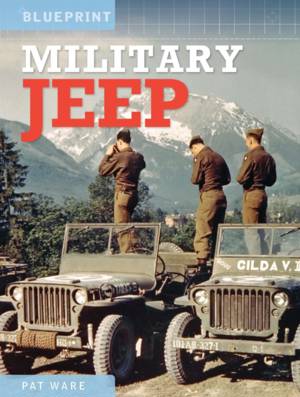
- Afhalen na 1 uur in een winkel met voorraad
- Gratis thuislevering in België vanaf € 30
- Ruim aanbod met 7 miljoen producten
- Afhalen na 1 uur in een winkel met voorraad
- Gratis thuislevering in België vanaf € 30
- Ruim aanbod met 7 miljoen producten
Zoeken
Military Jeep
Enthusiasts' Manual: 1940 Onwards - Ford, Willys and Hotchkiss
Pat Ware
Hardcover | Engels
€ 39,45
+ 78 punten
Omschrijving
The Jeep is among a handful of motor vehicles, along with other classics such as the VW 'Beetle', the Mini, the E-Type Jaguar and the Citroën 2CV which are deserving of that over used adjective; iconic.
During WW2, the Jeep could be found wherever the Allies were fighting and soldiers soon learned that here was a dependable, go-anywhere machine. Waterproofed Jeeps took part in the D-Day landings, before fighting their way across France and the Low Countries and into Germany. In the appalling conditions of the Eastern Front, Jeeps struggled against the odds to win the admiration of the Red Army and in the Far East where roads were non-existent, Jeeps were even adapted to travel on rails. By the time the war was over, more than 640,000 Jeeps had been built by Ford and Willys. After the end of the war another 28,000 were built in France by Hotchkiss during the 1950s.
This book, now enlarged and revised with many new pictures covers the story of the development of this iconic military vehicle and the myriad post-war 'lookalikes'. It also provides insights into what is involved in finding, restoring and running a military Jeep more than 80 years since the first prototype was delivered to the US Army in July 1940. It is a reliable guide to help enthusiasts find parts and decide how a particular Jeep can be authentically restored. The book's author, Pat Ware, is amongst the world's foremost writers on historical military vehicles, with more than 60 titles and countless magazine articles on his credits.
During WW2, the Jeep could be found wherever the Allies were fighting and soldiers soon learned that here was a dependable, go-anywhere machine. Waterproofed Jeeps took part in the D-Day landings, before fighting their way across France and the Low Countries and into Germany. In the appalling conditions of the Eastern Front, Jeeps struggled against the odds to win the admiration of the Red Army and in the Far East where roads were non-existent, Jeeps were even adapted to travel on rails. By the time the war was over, more than 640,000 Jeeps had been built by Ford and Willys. After the end of the war another 28,000 were built in France by Hotchkiss during the 1950s.
This book, now enlarged and revised with many new pictures covers the story of the development of this iconic military vehicle and the myriad post-war 'lookalikes'. It also provides insights into what is involved in finding, restoring and running a military Jeep more than 80 years since the first prototype was delivered to the US Army in July 1940. It is a reliable guide to help enthusiasts find parts and decide how a particular Jeep can be authentically restored. The book's author, Pat Ware, is amongst the world's foremost writers on historical military vehicles, with more than 60 titles and countless magazine articles on his credits.
Alleen bij Standaard Boekhandel
+ 78 punten op je klantenkaart van Standaard Boekhandel
Beoordelingen
We publiceren alleen reviews die voldoen aan de voorwaarden voor reviews. Bekijk onze voorwaarden voor reviews.












